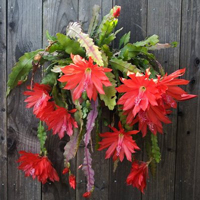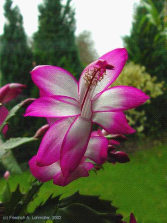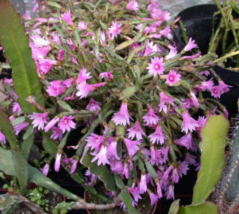 Epiphytic Cacti and Succulents
Epiphytic Cacti and Succulents
ORCHID CACTI (EPIPHYLLUMS)
These plants have been much neglected of late, despite their having the largest and most spectacular flowers in the cactus world (perhaps even the best flowers of any flowering plants). This neglect is probably due to the amount of space required for some of the plants in the past. This no longer holds true as many new varieties have been bred in recent years which are much smaller growing, and many basket varieties with a superb flower colour range are now available.
LIGHT
Full light from August - May. In summer slight shading is preferred - not too heavy or flowering may be reduced. A south-east window sill should be suitable for summer. A bronze tinge to the stems is normal but if most of the stem is coloured rather than green then the plants may be receiving too much sunshine.To be safe, keep above 40 deg. F.(4 deg. C.) in winter. Nearer 50 deg. F. (10 deg. C.) is better in the spring (March) when the buds are growing.
Most orchid cacti are however very tolerant and can stand much lower (some down to just above freezing) and much higher temperatures than these.
COMPOST
This can be varied according to the ingredients available. The most important points are -a)Neutral to slightly acid soil
b)Compost wets easily and drains easily and stays moderately moist for some time after watering.
A suggested compost to meet these requirements is (by volume):
1. Well - rotted leaf mould (oak is best) 60%
OR A mix of half moss-peat and half Sedge-peat 60%
2. A good loam 20%.
3. Sharp sand or Perlite or cat-litter 20%
WATERING
The most important thing is that the compost should never dry out completely.Keep plants just barely moist in winter.
Water well during the spring & autumn main growing periods, allowing the top 1/3 rd of the compost to dry before watering again.
Give the plants a little less water after flowering, when they appreciate a little rest.
During the hot, dry summer months, gentle misting is beneficial. Rainwater is best, cold tea second and tap water only as a last resort.
FEEDING
With this compost some feeding will be beneficial when watering. I recommend any feed suitable for tomatoes (i.e. low nitrogen, high potash).I feed every third watering during the spring and summer.
FLOWER PRODUCTION
Flowers should form on 2 -3 year old-plants. I recommend restricting the size of pot for maximum flower production. Orchid cacti with one or two cuttings per 6 inch or 8 inch pot can be kept at this size, and root bound, indefinitely. With mature plants, some of the old, marked stems should be cut back within six inches of the pot to encourage fresh growth and thus healthier and better-looking plants.Other Epiphytic Cacti
The same cultural conditions as given above apply to the following plants. The only difference is that a little more light should be given than recommended for Epiphyllums.
Other epiphytes worth growing include Heliocereus, Selenicereus (Queen of the Night), Aporocactus (Rat's Tails), Nopalxochia, Disocactus and Rhipsalis.
EASTER CACTIThe Easter Cacti are now known as Rhipsalidopsis or Hatiora.These produce their flowers in April and May, lasting for about six weeks, and will sometimes flower again in the autumn also. Cultivation is as for the Epiphyllum above, except that they should be kept cooler during the resting period from October until the buds become visible in the spring. Watering and feeding are then gradually increased and continued until late autumn. Easter cacti are more prone to segment drop on drying out than other epiphytes when watering is not regular.
|
|

CHRISTMAS CACTI
Christmas cacti are probably the best known and most popular houseplants in the world. They are popular because they are so easy to grow in the house and produce many flowers at a time when flowers are rarely seen.
Today, the Christmas cacti we see in the shops (- their Latin name is now Schlumbergera although they used to be called Zygocactus ) are all cultivars (horticultural hybrids) obtained by crosses ( or chance "sports") between the recognized nine species discovered in the wild.
Cultivation as for Epiphyllum above.
To guarantee flowering - Christmas cacti are "short day/long night” plants. They will only start to produce their buds when dark winter nights are longer than 13 hours. They must therefore be put somewhere where they get "natural" long nights
To overcome this problem, plants can be put outdoors from August to mid-September (in a shady place), or in any room not used for long periods at night. Once buds are visible, plants can be returned to their usual position in the house, and will develop flowers normally, whatever the light regime.
Plants will tend to flower more freely if tightly potted, so don't use too-large pots.
Temperature - Varieties vary, but most will flower at Christmas if kept at 50 to 55 deg. F (10 to 12 deg. C) from September to December. Kept at their advised minimum of 40 deg. F (5 deg. C) some may not flower until February.
To obtain pure flower colours with the white & yellow cultivars a minimum of 60 deg. F (14 deg. C) is needed (only from bud-set until flowering!) otherwise they will be tinged pink or orange.

